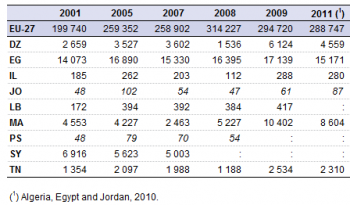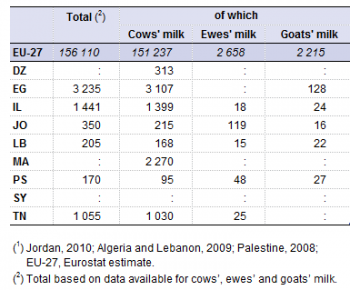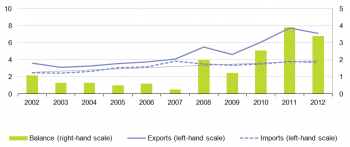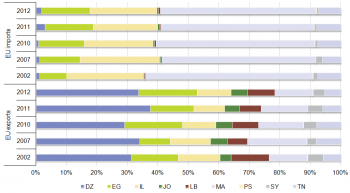Archive:Agriculture statistics - North Africa and Eastern Mediterranean
Agriculture in the ENP-South countries: largely determined by climatic conditions and influenced by cultural values
Statistics in focus 11/2014; Author: Rosemary MONTGOMERY
ISSN:2314-9647 Catalogue number:KS-SF-14-011-EN-N
This Statistics Explained article is outdated and has been archived - for recent articles on European Neighbourhood Policy countries see here.
Agriculture remains important in most of the ENP-South countries; less by its contribution to the gross value added of the national economy but rather as a source of employment. Linked to the topographic characteristics and the prevailing climatic conditions, the share of land used for agriculture is generally low, except for Tunisia (see Table 1).
The livestock reflects cultural traditions and is dominated by sheep. Morocco and Egypt are the main producers of cereals, although harvested quantities vary substantially according to annual rainfall. Moreover, Egypt is an important producer of fresh vegetables; its production in terms of weight corresponds to more than a third of the total European Union (EU) production.
EU trade in food and live animals with the ENP-South countries has risen over the last decade, particularly from 2008 onwards. Among the ENP-South countries, the EU imported mostly from Morocco. Algeria is the main destination of EU food and live animals exports.

Source: for the EU aggregates, Eurostat (online data codes: (nama_nace06_c), (lfsa_egana) and (lfsa_egan2); for the MED countries, Eurostat (online data codes: (med_ec5) and (med_ps414)

Source: for the EU-27, Eurostat (online data codes: (ef_ov_kvaa), (ef_kvaareg), (ef_poirrig) and (aei_ps_ira); for the MED countries, Eurostat (online data codes: (med_ag1)

Source: for the EU-27, Eurostat (online data code: (apro_cpp_luse); for the MED countries, Eurostat (online data code: (med_ag1) and (med_ps111)

Source: for the EU-27, Eurostat (online data code: (apro_cpp_crop); for the MED countries, Eurostat (online data code: (med_ag2)

Source: for the EU-27, Eurostat (online data code: (apro_cpp_crop); for the MED countries, Eurostat (online data code: (med_ag2)

Source: for the EU-27, Eurostat (online data code: (apro_cpp_crop); for the MED countries, Eurostat (online data code: (med_ag2)

Source: for the EU-27, Eurostat (online data codes: (apro_mt_lscatl), (apro_mt_lssheep) and (apro_mt_lsgoat); for the MED countries, Eurostat (online data code: (med_ag33)

Source: for the EU-27, Eurostat (online data code: (apro_mt_pann); for the MED countries, Eurostat (online data code: (med_ag31)

Source: for the EU-27, Eurostat (online data code: (apro_mk_farm); for the MED countries, Eurostat (online data code: (med_ag32)

Source: for the EU-27, Eurostat (online data code: (aact_eaa01); for the MED countries, Eurostat (online data code: (med_ag50)

Source: for the EU-27, Eurostat (online data code: (aact_eaa01); for the MED countries, Eurostat (online data code: (med_ag50)

Source: for the EU-27, Eurostat (online data code: (aact_eaa01); for the MED countries, Eurostat (online data code: (med_ag50)
Main statistical findings
Agriculture concentrated in coastal regions and river valleys
The ENP-South countries encompass a wide variety of ecosystems and habitats. The majority of the region consists of arid habitats, especially those regions away from the coast and the larger river valleys. Semi-desert areas and desert wadis (dry river valleys) support sparse grasslands and shrublands, which are mostly used for goat and sheep grazing. Large areas consist of sand and rock desert (particularly in the south of the region), which are mostly devoid of vegetation, but are nevertheless of high biodiversity value for their specialist species and communities.
Mediterranean coastal areas receive more rainfall than inland and, as a result, these regions support woodland and shrubland ecosystems. These used to dominate large areas (such as in northern Israel), but a high proportion has been converted into agricultural land, urban areas, or planted forests (mostly pine). Similarly the humid river valleys (such as that of the Nile) used to support extensive wetlands and floodplain grasslands, but most of these natural habitats have now been converted to agriculture.
Agricultural sector remains a considerable source of employment
The economic importance of the agricultural sector (including fishing) varies considerably among the ENP-South countries; it represented between 2 % and 4 % of the gross value added (GVA) of Israel, Jordan and Lebanon respectively in 2011 but a little over 15 % in Morocco and 20 % in Syria (2009). By way of comparison, it contributed 1.7 % to the total GVA of the EU-27 in 2010 (see Table 1). Nevertheless, there was a broad decline in the economic importance of agriculture in the region between 2003 and 2011; the decline in Egypt from a 16.3 % share in 2003 to 13.2 % in 2011 was particularly clear.
This difference in the importance of the agricultural sector between the ENP-South countries was even starker in terms of employment. In Israel and Jordan, the sector (including hunting, forestry and fishing) provided between 1-2 % of total employment, which were lower shares than the respective, relative contributions to total GVA. In the other countries of the region for which data are available, agriculture was a much more important employer, accounting for between one in every nine persons employed in Algeria, one in every seven in Syria and about one in every six persons employed in Tunisia in 2011.
However, in Morocco, the sector provided employment for about two in every five persons (39.8 %) in employment in 2011, making agriculture, forestry and fishing the largest sector within the national economy in terms of employment. Nevertheless, it should be noted that fishery activities make up a significant part of this, thanks to the country's access to the Mediterranean Sea, and the rich fishing grounds in the Canary Current off the country's west coast. By way of comparison, only 5.0 % of total employment in the EU was in agriculture, forestry and fishing.
Region characterised by small farms, except Tunisia
Structural data on farms in the ENP-South countries are rather patchy. However, available data suggest that there are relatively high numbers of agricultural holdings in the ENP-South countries as a whole, with the number in Egypt alone corresponding to just over one third of the total number of holdings across the EU in 2010 (4.2 million holdings in Egypt compared with 12.0 million holdings in the EU).
The average agricultural holding of the ENP-South countries was typically of a much smaller size than the average farm in the EU. Among the five ENP-South countries for which data are available (no data for Israel, Lebanon, Morocco and Syria), the average utilised agricultural area per holding ranged between 0.9 ha (2010 data) in Egypt to 17.9 ha (2010 data) in Tunisia. Only in Tunisia did the average farm size exceed the EU average (14.3 ha in 2010).
Increased use of irrigation
In many of the ENP-South countries the area of farmland in production increased between 2003 and 2011. The strongest increases were in Egypt (+6.2 %) and Jordan (+9.2 %, 2003 - 2010). The major exceptions were Israel and particularly Palestine where the utilised agricultural areas declined sharply during the same reference period (by -13.0 % and -43.4 % respectively). Given the desert nature of a large part of the countries, it is not surprising that less than 4 % of the total land area of Algeria, Egypt and Jordan (2010 data) was used as agricultural land in 2011, compared to just over two-fifths (40.9 %) of the land area of the EU-27. Only in Tunisia (56.5 %) was the share higher than the EU average.
In most ENP-South countries, there was also an increase in irrigated area (notable exceptions being in Palestine, where the utilised agricultural area as a whole declined sharply, and in Egypt where it fell back from high levels), in contrast to the decline noted for the EU. Reliance on irrigation for agricultural production varied considerably among the countries; in 2011, the proportion of utilised agricultural area that was irrigated ranged from 4.5 % in Tunisia, through 39 % in Jordan and upwards of 50 % in Israel and Lebanon, to 67.7 % in Egypt (where agricultural activities are largely concentrated in the Nile valley and its delta).
Crop production quantities highly dependent on precipitation
Unpredictable and erratic precipitation patterns in the ENP-South countries have a significant impact on the quantities of crops harvested. This variability becomes particularly visible when looking at the cereals production figures for the countries of North Africa in 2008 (Table 3), when a lack of rainfall led to much lower harvests than in most other years of the reference period displayed.
Egypt and Morocco were the largest cereal producers among the ENP-South countries (producing 15.2 million tonnes in 2010 and 8.6 million tonnes in 2011, respectively), the main crops of which were wheat (both countries), barley (Morocco) and grain maize (Egypt) – see Table 4.
Egypt was also the largest producer of fresh fruit and vegetables among the ENP-South countries (see Table 5). By way of comparison, the 21.6 million tonnes of fresh vegetables produced in Egypt alone in 2010 was the equivalent of more than one third of the total quantity produced in the EU.
Animal husbandry characterised by tradition
Livestock production in the ENP-South countries is shaped by climatic and topographic conditions but also by cultural traditions. Sheep and goats are highly adaptable forage animals suited to arid and semi-arid conditions. Populations of sheep and goats tended to be much larger than cattle in the ENP-South countries (see Table 6), providing an important source of meat (see Table 7), milk (see Table 8), woollen fibres and skins.
Poultry production was higher than other forms of animal production in all ENP-South countries (data for Syria not available). Only in Egypt, did the slaughter weight of the meat of bovine animals (0.9 million tonnes) come close to that of poultry meat (1.0 million tonnes).
The use of local or indigenous cattle is more typical of the region, as they are well adapted to the climatic conditions, available feed and water resources as well as diseases and parasites. As in the EU, cows' milk constitutes the largest share of total milk production in each of the ENP-South countries. However, the ENP-South countries produce a lot less of it than the EU (see Table 8), reflecting not only a much smaller dairy herd but also the fact that apparent milk yields are often considerably lower than in the EU.
By way of example, average milk yields in Algeria and Morocco were typically less than (and sometimes much less than) 1 400 kg per year per cow in the period between 2003 and 2011. The yields rose to about 2 600 kg in Tunisia (2011) and Syria (2006) and 4 000-5 000 kg in Lebanon and Palestine. In contrast, the average milk yield per cow in the EU was 6 600 kg per year (with a number of Member States over the 8 000 kg level). There were exceptions in the region though. Average apparent milk yields rose quickly and sharply in Jordan during the period between 2003 and 2009 (to 6 350 kg per cow) but were consistently at the top end globally in Israel (an apparent yield of 11 400 kg per cow in 2011).
Sheep and goats are often considered the 'poor man's cow' for whom they are a key source of milk and meat. These animals are often kept in environments where there is scarce grazing and unfavourable climatic conditions. This helps explain why sheep and goats' milk accounted for almost 40 % of total milk production in Jordan (2010) and 45 % in Palestine (2008).
Farming considerably less input-intensive than in the EU
The value of agricultural output measured in euros increased relatively sharply and steadily over the ten years through to 2011 in Algeria, Israel and Morocco — see Table 9. In comparison, it remained relatively steady for much of the reference period in Tunisia, and fluctuated strongly in Egypt, albeit finishing sharply higher in 2010.
In all the ENP-South countries for which data are available, as for the EU, a majority of the value of agricultural output was generated from crop production. The share ranged from 57 % in Algeria to 62 % in Morocco in 2011, crop production contributing 57 % of agricultural output value in the EU.
Although the information in Figure 3 can only be considered a snapshot of the situation in two specific years, the use of agricultural inputs (such as feeding stuffs, pesticides and herbicides, called intermediate consumption) varies annually, partly reflecting the changing needs due to climatic conditions. Available annual figures show that in Algeria, Israel and Palestine, intermediate consumption (in euros), expressed as a share of agricultural production has increased relatively steadily. Conversely the shares showed a decreasing trend in Egypt and Morocco.
In all of the ENP-South countries, intermediate consumption costs accounted for a lower share of agricultural output value than in the EU‑27 (60.7 % in 2011). Palestine was the only country which comes close to this share (estimated value). This suggests that farming in the ENP-South countries (with the exception of Israel) was generally far less input-intensive on average than farming in the EU.
Trade in food and live animals: Morocco most important for EU imports, Algeria for EU exports
EU trade in food and live animals with the ENP-South countries rose considerably between 2002 and 2012, but particularly from 2008 onwards, to reach a peak in 2011.
In terms of value, EU imports of food and live animals from the ENP increased from 2.5 billion euros in 2002 to 3.7 billion in 2012, underlining the importance of the EU as an export market for the ENP-South countries. During the same period, EU exports of food and live animals to the ENP-South countries nearly doubled in value from 3.6 billion euros to 7.1 billion (peaking in 2011 at 7.7 billion). As a result of this growth in trade, the positive trade balance of the EU in food and live animals widened from 0.3 billion euros in 2007 to 3.4 billion in 2012.
About one half (51 %) of all food and live animals imported into the EU from the ENP-South countries came from Morocco in 2012. Israel and Egypt accounted for the most of the rest (22 % and 16 % respectively).
In contrast, there was a much wider spread of ENP-South export markets for EU food and live animals. Algeria accounted for about one third (34 %) of EU food and live animals exports to ENP-South countries in 2012, Egypt for about one fifth (19 %) and Morocco, Israel and Lebanon together accounting for a further one third.
Data sources and availability
The data for the ENP are supplied by and under the responsibility of the national statistical authorities (NSIs) of each of the countries or territories on a voluntary basis. Data from other sources are very limited and clearly identified. The data for Algeria, Egypt, Israel, Jordan, Lebanon, Morocco, Palestine, Syria and Tunisia are collected by Eurostat directly from the relevant NSIs. The statistics that are included in this article are freely available on-line and form part of the Pocketbook on Euro-Mediterranean statistics - 2013 edition.
Context
This article presents selected statistics and analyses on the economic importance of the agricultural sector for nine Mediterranean countries covered by the European Neighbourhood Policy (ENP-South countries). It provides an overview of the agriculture contribution to their economy, employment, trade in food and live animals, the livestock and crops situation in Algeria (DZ), Egypt (EG), Israel (IL), Jordan (JO), Lebanon (LB), Morocco (MA), Palestine (PS), Syria (SY) and Tunisia (TN). The policy context of the European Neighbourhood Policy (ENP) is explained in International statistical cooperation.
See also
Further Eurostat information
Publications
- Pocketbook on the Euro-Mediterranean statistics – 2013
- Pocketbook on the Euro-Mediterranean statistics – 2012
- Pocketbook on the Euro-Mediterranean statistics – 2011
Database
- European Neighbourhood Policy Country (ENP-South) (med)], see:
- Agriculture (med_ag)
Dedicated section
Methodology / Metadata
- Southern European Neighbourhood Policy countries (ENP-South) (ESMS metadata file — med_esms)
External links
- European External Action Service – Euro-Mediterranean Partnership (EUROMED)
- European External Action Service - European Neighbourhood Policy

